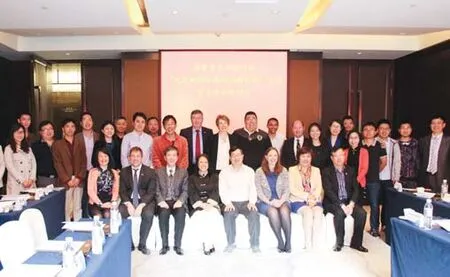通过血清、唾液可快速诊断肝炎中英联合启动研发获得英国牛顿基金支持的重大项目
2017-07-31胡睿
□ 文/本刊记者 胡睿
通过血清、唾液可快速诊断肝炎中英联合启动研发获得英国牛顿基金支持的重大项目
□ 文/本刊记者 胡睿

嘉宾合影,英国驻重庆总领事馆总领事艾佩诗(前排左四)出席会议。
五方科研团队联合申请
4月12日,中英联合研发项目“一种肝炎诊断检测集成试剂盒的联合研发与产业化”国家重点研发计划重点专项在重庆大学启动。出席会议的有英国驻重庆总领事馆总领事艾佩诗女士,英国Biovici公司、英国斯旺西大学Owen Guy教授团队、英国国家物理实验室Olga Kazakova教授团队,重庆大学副校长王时龙教授、重庆大学科技处副处长刘敢新教授、重庆大学光电工程学院常务副院长郭永彩教授等相关领导,以及重庆大学刘玉菲教授团队和常州碳维纳米科技有限公司等项目科研团队。作为国家重点研发计划“政府间国际科技创新合作”重点专项—中英研究与创新桥计划首个启动项目,该项目还得到英国牛顿基金支持。项目总投资约为1600万元人民币(约186万英镑)。
据了解,这个由青年千人计划专家、重庆大学刘玉菲教授团队、英国Biovici公司、英国斯旺西大学Owen Guy教授团队、英国国家物理实验室Olga Kazakova教授团队和常州碳维纳米科技有限公司等5方组成的科研团队联合申请的项目,将开发用于肝炎诊断的新型即时诊断设备,为监控血清、唾液肝炎标志物开发一种具商业用途的快速传感器,并探索其商业化,为病患提供帮助。该项目为中英研究与创新桥计划中英联合资助的15个项目之一。
通过血清、唾液可快速诊断肝炎
在启动会上,重庆大学光电工程学院教授、该项目高校技术负责人刘玉菲教授介绍:“全球有近20亿人感染了病毒性肝炎,其中25%遭受慢性或长期感染,每年有100万人死于肝硬化和肝癌。以我国为例,大约有1.3亿人感染乙型肝炎,4000万人感染丙型肝炎,病患死亡率高达40%。”他提出,如果能实现早期诊断,就能有效提升患者的诊疗效果,预防肝炎传染。
据介绍,五方联合开发的肝炎诊断检测集成试剂盒,其技术核心是在一种微流控芯片与特异性检测上。“根据我们的初步设计,微流控芯片上划分有甲肝、乙肝、丙肝3个检测区,每个检测区有多个检测单元。”刘玉菲举例说,比如在乙肝检测区,如果3个检测单元都呈阳性或阴性,这是很好得出诊断结果的,如果呈现一个或两个阳性,那经过进一步数据分析,再得出诊断结果。这也避免了假阳性或阴性的情况,让肝炎诊断更加精准。微流控芯片上有几十甚至上百个微流控通道,集成了许多石墨烯传感器,当血液或唾液样本进入微流控芯片后,在运输、混合、筛选之后,石墨烯传感器就能快速找到血清或唾液肝炎标志物,分析诊断出样本是否受到肝炎感染。
科研产品预计2019年面市
简单来说,只需要检测患者的一滴血清或唾液,便能使用这项科研产品在几分钟的时间内快速诊断出是否感染肝炎,“该类产品的年市场需求超过4.25亿英镑,研发的产品预计2019年推向市场。”刘玉菲表示。
此次合作的五方将分别负责石墨烯材料制备、材料表征与测试、传感器加工与集成、石墨烯表面修饰、检测电路与分装,并准备在华设立合资公司,共同推动石墨烯材料及试剂盒产品的全球销售。另外,在项目启动会上,重庆大学、英国斯旺西大学、英国国家物理实验室联合设立的“智能感知技术协同创新中心”也正式揭牌,未来,三方将在人工智能、智能传感、脑科学与神经科学等领域展开全方位的合作与探索。
(图片由重庆大学光电工程学院教授刘玉菲提供)
On April 12, a key project of national key R&D plan—“Joint R&D and industrialization of an integrated kit for hepatitis diagnosis and detection”—which is operated by China and UK, was launched in Chongqing University. Participants included Ms. Cecille El Beleidi,Consul General of British Consulate-General in Chongqing, Biovici Company in British, Professor Owen Guy and his teams from Swansea University, Professor Olga Kazakova and his teams from National Physics Laboratory, Professor Wang Shilong,vice-principal of Chongqing University, Professor Liu Ganxin,deputy director general of department of science and technology,Chongqing University, Professor Liu Yufei and his teams from Chongqing University and Changzhou Tanwei Nanometer Science and Technology Co., Ltd. As a major project of national key R&D plan in the “Intergovernmental cooperation in international scienti fi c and technological innovation”, the fi rst startup project of China-UK Research and Innovation Bridge Program, this project also has gained the support of British Newton Fund. The total investment of the project is about ¥16 million RMB (£1.86 million).
It is understood that this project was jointly applied by fi ve research groups: Professor Liu Yufei, expert of the Recruitment Program of Global Experts, and his teams; Biovici Company; Professor Owen Guy and his teams from Swansea University; Professor Olga Kazakova and his teams from National Physics Laboratory;Chongqing University and Changzhou Tanwei Nanometer Science and Technology Co., Ltd. This research group will develop a new diagnostic device for hepatitis diagnosis and develop a fast sensor for commercial use to monitor serum, saliva and hepatitis markers. After putting this sensor into market, patients can bene fi t from it. This project also represents one of the fifteen projects jointly supported by China and UK in the China-UK Research and Innovation Bridge Program.
Professor Liu Yuqing: Hepatitis can be quickly diagnosed by serum and saliva
As the university technical leader and the professor of school of optical engineering in Chongqing University, Liu Yufei made an introduction on the launching ceremony. He said nearly 2 billion people worldwide are infected with viral hepatitis, among which 25% infected person are subjected to chronic infection. Every year, one million people die from cirrhosis and liver cancer. Taking China as an example, about 130 million people are infected with hepatitis B, 40 million are infected with hepatitis C, and the death rate is as high as 40%. Liu also provided that the diagnosis and treatment effect of infected person can be effectively improved by the realization of early diagnosis to prevent hepatitis infection.
According to the presentation, the technical core of this integrated kit for the purpose of hepatitis diagnosis developed jointly by fi ve parties lies on micro fl uidic chip and its speci fi c detection. According to our preliminary design, there are 3 detection areas of hepatitis A, hepatitis B and hepatitis C on the microfluidic chip and each detection area has a plurality of detection units, explained by Liu. For example, in the area of hepatitis C, if the 3 test units are positive or negative, this will be easy for the diagnosis; if one or two are positive, further data analysis should be done to obtain the diagnosis. It also avoids false positives or negative cases,making hepatitis diagnosis more accurate. Microfluidic chips are equipped with dozens of, or even hundreds of microfluidic channels, integrated with many graphene sensors. When the blood or saliva samples come into the microfluidic chip, after mixing,transportation, filtering, graphene sensors will be able to quickly fi nd the saliva or serum markers of hepatitis to analyze whether the sample is infected with hepatitis or not.
Research products are expected to be available in 2019
In simple terms, with only one drop of serum or saliva from the patient, the research product can be used to quickly diagnose hepatitis infection in a few minutes. The market demand of this kind of products exceeds 425 million pounds, and the products are expected to be put into the market in 2019, said by Professor Liu.Five parties in this cooperation are responsible for the preparation of graphene material, material characterization and testing, sensor processing and integration, the surface modi fi cation of graphene,and detection circuit and packaging respectively. They also prepared to set up joint venture in China to jointly promote the global sales of graphene materials and reagent kits. In addition,“Collaborative Innovation Center of Intelligent Sensing Technology”jointly established by Chongqing University, Swansea University,National Physics Laboratory also was of fi cially inaugurated. In the future, those three parties will carry out all-round cooperation and exploration in the areas of arti fi cial intelligence, intelligent sensing,brain science and neuroscience.
A Major Project Supported by British Newton Fund Was Launched by Both China and UK in Chongqing:Hepatitis can be quickly diagnosed by serum and saliva
□ Article / journalist Hu Rui
